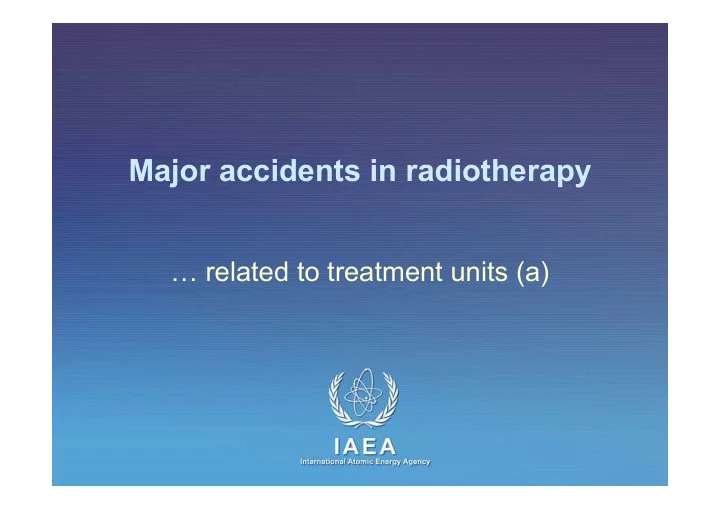

Major accidents in radiotherapy … related to treatment units (a) IAEA International Atomic Energy Agency
Incorrect decay data (USA) IAEA International Atomic Energy Agency
Background • A cobalt unit was used for teletherapy at Riverside Hospital in Columbus, Ohio, USA • This unit was initially calibrated correctly Cobalt unit (not the actual unit in Ohio) IAEA Prevention of accidental exposure in radiotherapy 3
Background • During the period 1974-1976 the physicist failed to perform regular measurements (calibrations and QA) • The physicist relied on estimations of the decay of the source to predict dose rate and calculate treatment time • Rather than calculated decay, the physicist plotted dose rate on graph paper and extrapolated IAEA Prevention of accidental exposure in radiotherapy 4
What happened? Decay was determined from straight-line plot on semi-log graph paper with calendar ordinate IAEA Prevention of accidental exposure in radiotherapy 5
What happened? When edge of graph paper was reached, physicist continued plot on linear paper IAEA Prevention of accidental exposure in radiotherapy 6
What happened? • The physicist used a continuation page that had linear scales on both axes • This created two problems: - Linear Y-axis did not correspond to log Y-axis, so straight line extrapolation resulted in ever more incorrect output values - Linear X-axis did not correspond to calendar axis, so extrapolation led to incorrect date values IAEA Prevention of accidental exposure in radiotherapy 7
Magnitude of accident • These errors in predicting the dose-rate were made by the physicist in the time period 1974-1976 • The errors resulted in: - Dose-rate being under-estimated by 10% to 45%. - Patients received corresponding overdoses of 10% to 55%. • Magnitude of error increased almost linearly with time IAEA Prevention of accidental exposure in radiotherapy 8
Magnitude of accident Patient Overdoses Percent Overdose [%] 100 50 10 Aug-74 Nov-74 Mar-75 Jun-75 Sep-75 Jan-76 Apr-76 Year/Month IAEA Prevention of accidental exposure in radiotherapy 9
Discovery / investigation of accident • The incident came to light because patients started exhibiting symptoms of overexposure • The accident was investigated by the US Nuclear Regulatory Commission IAEA Prevention of accidental exposure in radiotherapy 10
Investigation: further complications • When requested, the physicist produced ten calibration documents showing the correct machine output • These were discovered to have been fabricated • The output of the cobalt unit had not been checked for 22 months IAEA Prevention of accidental exposure in radiotherapy 11
Impact of accident • 426 patients received significant overdoses • 11 were untraced - 415 followed up • 795 sites at risk identified • 57% (243) died within the first year • In 87 patients there was local control with no documented recurrence • Survivors beyond the second year had an increased frequency of complications IAEA Prevention of accidental exposure in radiotherapy 12
Impact of accident • 426 patients received significant overdoses Patient Profile 450 400 350 300 Number of Subjects Dead 250 Recurred 200 Lost Cured 150 100 50 0 1 2 3 4 5 6 7 8 9 10 11 12 13 14 15 Year of Followup IAEA Prevention of accidental exposure in radiotherapy 13
Lessons: Radiotherapy Department • Include in the Quality Assurance Programme: - Independent check of physicist’s work - Formal procedures for calibrating treatment unit on a regular schedule - Department should provide sufficient staff to handle workload - Records must accurately document performance of accepted QA procedures - Establish an accurate database for follow-up IAEA Prevention of accidental exposure in radiotherapy 14
Lessons: Radiotherapy Department • In case of unusual reactions in one patient - notified by a technologist or directly by the patient - the radiation oncologist should immediately request the medical physicist to perform a verification to detect a possible error in any of the treatment steps • Unusual reactions in more than one patient should lead to a request to the medical physicist to immediately verify the dosimetry of the treatment unit IAEA Prevention of accidental exposure in radiotherapy 15
References • Cohen L, Schultheiss T E, Kennaugh R C. A radiation overdose incident: initial data. Int J Radiat Oncol Biol Phys 33: 217-224 (1995) • ICRP Publication 86: Prevention of accidental exposures to patients undergoing radiation therapy (2000) IAEA Prevention of accidental exposure in radiotherapy 16
Recommend
More recommend